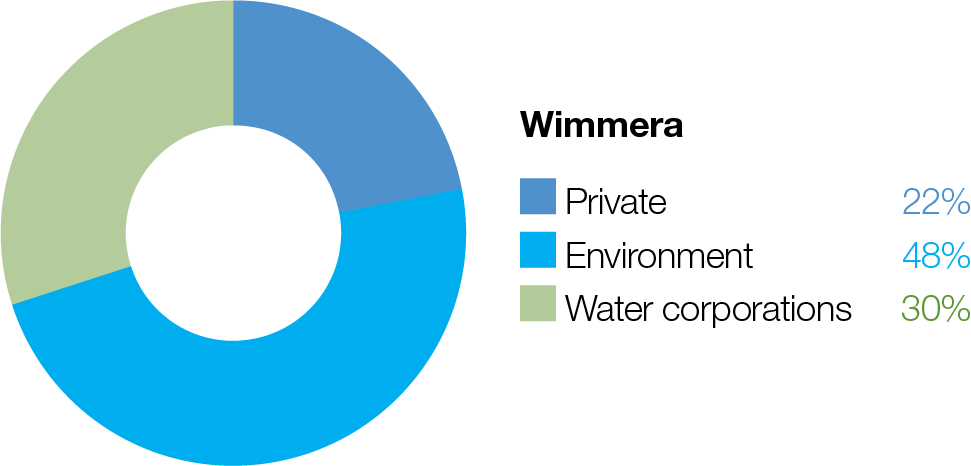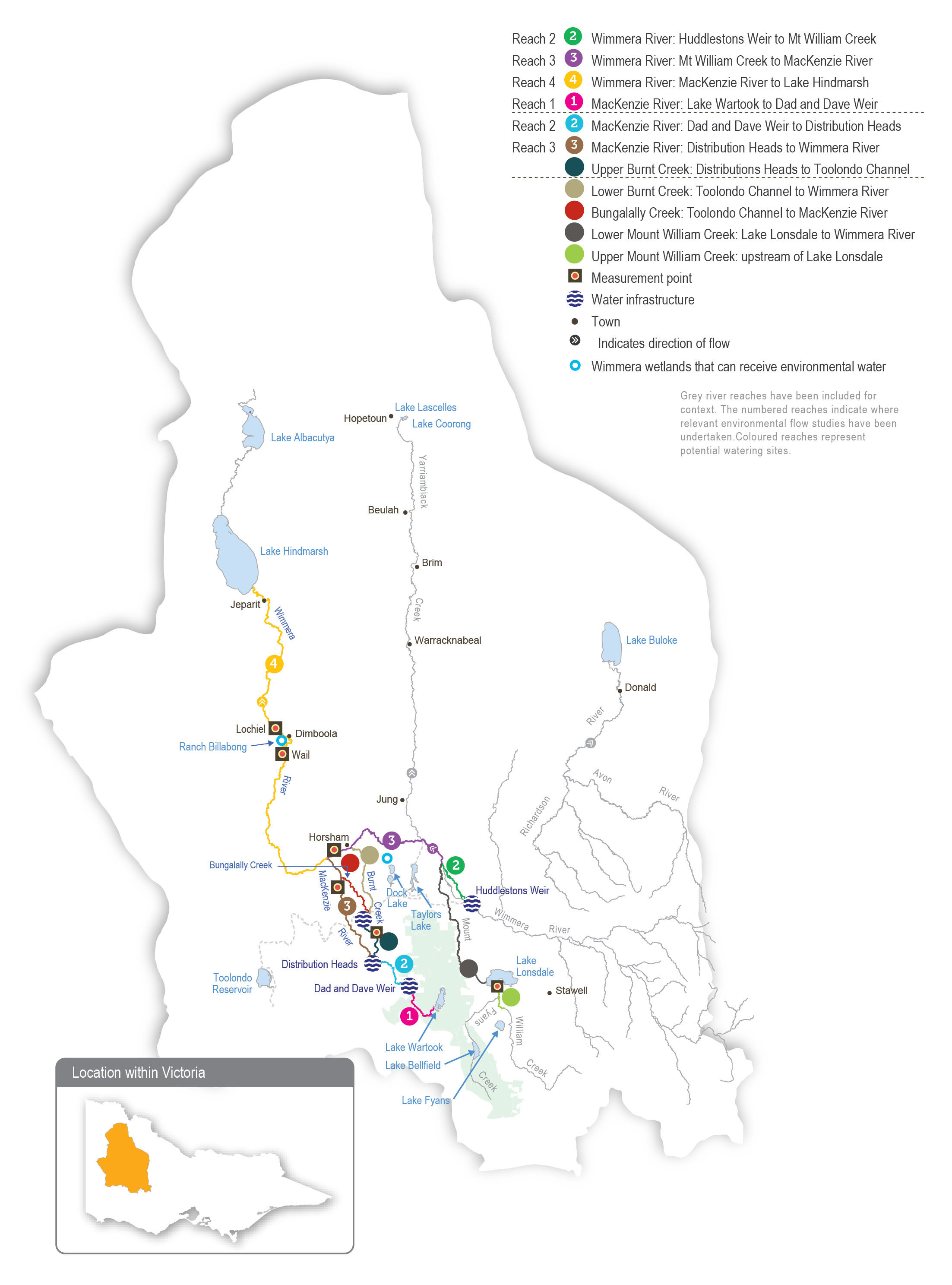Wimmera River (reach 4) |
Winter/spring low flow (30 ML/day during June to November)  
| - Maintain access to habitat for native fish, waterbugs and in-stream vegetation
|   
|
Small winter/spring fresh(es) (one to five freshes of 70 ML/day for one to four days during June to November)  
| - Increase water depth to provide a stimulus for fish movement
- Provide flow variability to maintain water quality and diversity of fish habitats
|  
|
Medium winter/spring fresh(es) (one to three freshes of 200 ML/ day for one to three days during June to November) | - Provide variable flow during the high-flow season for fish movement
- Provide flow variability to maintain water quality and diversity of fish habitats
- Wet lower benches to support native streamside vegetation, entrain organic debris and maintain habitat for waterbugs and fish
|    
|
Summer/autumn low flow (15 ML/day or natural during December to May)   | - Maintain edge habitats in deeper pools and in-stream habitat to support native fish populations and waterbugs
- Maintain soil moisture for streamside vegetation and near-permanent inundated stream channel for aquatic vegetation and prevent the growth of terrestrial plants in the stream bed
|  
|
Summer/autumn fresh(es) (one to three freshes of 70 ML/day for two to seven days during December to May)   | - Flush pools to prevent a decline in water quality and to maintain habitat for fish and waterbugs
- Provide fish passage to allow fish to move through the reach
|   
|
MacKenzie River (reach 3) |
Winter/spring low flow (10 ML/day or natural during June to November) | - Maintain edge habitats and deeper pools and runs for waterbugs and platypus
- Maintain soil moisture for streamside vegetation and near-permanent inundated stream channel for aquatic vegetation and prevent the growth of terrestrial plants in the stream bed
- Maintain pool habitat for native fish and crayfish populations
|    
|
Winter/spring freshes (five freshes of 35 ML/ day for two to seven days during June to November) | - Stimulate fish movement by increasing flow rates and water depth and increase habitat availability for platypus and waterbugs
- Flush pools to prevent a decline in water quality
- Maintain soil moisture for streamside vegetation
|     
|
Summer/autumn low flow (10 ML/day or natural during December to May) | - Maintain edge habitats and deeper pools and runs for waterbugs and platypus
- Maintain soil moisture for streamside vegetation and near-permanent inundated stream channel for aquatic vegetation and prevent the growth of terrestrial plants in the stream bed
- Maintain pool habitat for native fish and crayfish populations
|    
|
Summer/autumn freshes (three to four freshes of 35 ML/day for two to seven days each during December to May) | - Flush pools to prevent a decline in water quality and to increase habitat availability for waterbugs and native fish
|   
|
Upper Burnt Creek |
Winter/spring low flow (1 ML/day or natural during June to November) | - Maintain edge habitats and shallow-water habitat for waterbugs
- Maintain soil moisture for streamside vegetation and near-permanent inundated stream channel for aquatic vegetation and prevent the growth of terrestrial plants in the stream bed
- Maintain a sufficient area of pool habitat for native fish and crayfish populations
|   
|
Winter/spring fresh(es) (one to five freshes of 55 ML/day for three to seven days during June to November) | - Allow fish to move throughout the reach
- Flush sediments from hard substrates to increase biofilm production and food for waterbugs
|   |
Summer/autumn low flow (1 ML/day or natural during December to May) | - Maintain edge habitats and shallow-water habitat for waterbugs
- Maintain soil moisture for streamside vegetation and near-permanent inundated stream channel for aquatic vegetation and prevent the growth of terrestrial plants in the stream bed
- Maintain a sufficient area of pool habitat for native fish and crayfish populations
|   
|
|
Summer/autumn freshes (three freshes of 30 ML/ day for two to seven days each during December to May)
| - Prevent a decline in water quality by flushing pools in the low-flow season
- Allow fish to move throughout the reach
- Flush sediments from hard substrates to increase biofilm production and food for waterbugs
|   
|
Lower Burnt Creek |
Bankfull fresh (one fresh of 45 ML/day for two days at any time) 
| - Inundate streamside vegetation to maintain plant condition and facilitate recruitment
- Move organic debris in the channel to support waterbugs
- Maintain the structural integrity of the channel
|  
|
Bungalally Creek |
Bankfull fresh (one fresh of 60 ML/day for two days at any time) 
| - Inundate the streamside zone to maintain its condition and facilitate the recruitment of streamside vegetation communities
- Maintain the structural integrity of the channel and prevent the loss of channel capacity
| 
|
| Upper Mount William Creek
|
|
Top-up of pools (summer/autumn)
| - Maintain edge and shallow-water habitat for native fish and waterbugs
- Maintain water quality
|   
|
| Lower Mount William Creek
|
Year-round low flow (5 ML/day or natural) 
| - Maintain edge habitats and shallow-water habitat for waterbugs and endemic fish
- Maintain soil moisture for streamside vegetation and near-permanent inundated stream channel for aquatic vegetation and prevent the growth of terrestrial plants in the stream bed
|  
|
Winter/spring fresh(es) (one to five freshes of 100 ML/day for one to seven days during June to November) | - Wet benches to entrain organic debris and allow native fish to move throughout the reach
- Flush surface sediments from hard substrates to support waterbugs
- Inundate the streamside zone to maintain its condition and facilitate the recruitment of streamside vegetation communities
|   
|
|
Summer/autumn freshes (three freshes of 20-30 ML/day for two to seven days during December to May)
| - Prevent a decline in water quality by flushing pools during low flow
- Provide a variable flow and allow the movement of fish and waterbugs throughout the reach during the low-flow season
|   
|
| Dock Lake
|
|
Winter/spring partial fill
| - Trigger the growth and germination of wet-phase wetland vegetation communities
- Support feeding and breeding habitat for waterbirds, frogs, waterbugs and turtles
|     
|
| Ranch Billabong
|
Top-ups (winter/spring and summer/autumn)  | - Inundate wetland vegetation to maintain plant condition and facilitate recruitment
- mprove water quality for frogs and waterbirds
|   
|





